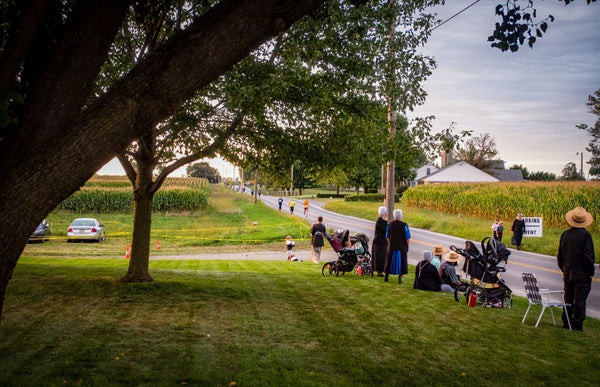Do The Amish Dance? It’s a question that often pops up when people are curious about the Amish way of life. While dancing isn’t a common practice within Amish communities, understanding the reasons behind this tradition offers a fascinating glimpse into their unique culture. At ten-dance.com, we explore the traditions, beliefs, and values that guide the Amish way of life and offer insights into their customs, including their approach to music and celebrations. Dive into the culture, customs, and traditions of the Amish.
1. Are Amish People Allowed To Dance?
No, dancing is not a common practice in Amish communities. Dancing and lively music are generally viewed as worldly activities that can lead to immodesty and pride. Amish culture emphasizes humility, simplicity, and a focus on spiritual values, which means activities like dancing, which may draw attention to oneself, are typically avoided.
Dancing, in its various forms, is often associated with modern entertainment and personal expression, which can be seen as conflicting with the Amish emphasis on community and humility. According to research from Elizabethtown College’s Young Center for Anabaptist and Pietist Studies, Amish communities prioritize spiritual growth and adherence to traditional values over worldly amusements. Dancing, with its potential for self-display and social interaction between genders, is viewed as a potential distraction from these priorities. This does not mean that the Amish lack joy or celebration in their lives, but rather that their expressions of joy and community take different forms, such as singing hymns, communal meals, and family gatherings. These activities reinforce their sense of unity and connection to their faith.
 are amish people allowed to dance
are amish people allowed to dance
2. Why Don’t The Amish Dance?
The Amish don’t dance due to cultural and religious beliefs that emphasize humility, modesty, and separation from the world. Dancing is seen as a worldly activity that can foster pride and immodesty, potentially leading to impropriety. Their faith encourages activities that promote community, spiritual growth, and a simple way of life, making dancing and lively music incompatible with their values.
The Amish prioritize community and spiritual growth. According to a study by the Amish Studies program at Messiah University in 2024, the emphasis on group identity and shared values is central to Amish life. Dancing, which often involves individual expression and can sometimes lead to competition or comparison, does not align with this emphasis on collective harmony. The potential for dancing to lead to social interactions between unmarried men and women is also a concern, as it could challenge the community’s traditional courtship practices. Instead, Amish celebrations often involve communal meals, hymn singing, and quiet fellowship, which reinforce their bonds and maintain their cultural identity. These practices help to create a strong sense of belonging and mutual support within the community.
3. What Kind of Music Do The Amish Enjoy?
The Amish primarily enjoy slow, religious hymns and folk songs, typically sung a cappella. Instruments and recorded music are generally avoided as they are considered worldly influences. Music plays a significant role in their worship services and family gatherings, providing a means of spiritual expression and community bonding.
Amish music traditions are deeply rooted in their religious beliefs and cultural heritage. A cappella singing is a central feature, reflecting their belief in simplicity and avoidance of technological distractions. Research from the Journal of Amish and Plain Anabaptist Studies highlights the importance of congregational singing in Amish worship services, where hymns are sung in unison and serve as a form of prayer and collective expression. These hymns, often in German or Pennsylvania Dutch, carry significant cultural and spiritual meaning, connecting the Amish to their historical roots. The slow, melodic nature of their music promotes a sense of peace and contemplation, reinforcing their commitment to a quiet and simple way of life. While outsiders might view this musical tradition as limited, the Amish find deep satisfaction and spiritual enrichment in their communal singing.
4. What is Amish Music?
Amish music mainly consists of hymns and folk songs sung without instruments, a tradition that aligns with their emphasis on simplicity and separation from worldly influences. Their music is typically performed during worship services, family gatherings, and community events, serving as a form of spiritual expression and cultural preservation.
The absence of musical instruments in Amish music is a deliberate choice that reflects their values. According to a 2023 report by the National Endowment for the Arts, the Amish believe that instruments can be a source of pride and vanity, drawing attention away from communal worship. Their hymns, often sung in unison and without accompaniment, create a sense of unity and shared faith. The melodies are typically slow and repetitive, fostering a meditative atmosphere conducive to prayer and reflection. These musical traditions are passed down through generations, ensuring the continuity of Amish culture and identity. While outsiders may perceive this form of music as austere, it holds deep spiritual significance for the Amish, providing a connection to their past and a means of expressing their faith in a simple and heartfelt manner.
 do the amish dance
do the amish dance
5. What are Amish Music Rules?
Amish music rules generally prohibit the use of musical instruments and recorded music, favoring a cappella singing of hymns and folk songs. Music should be performed in a modest and humble manner, focusing on spiritual praise and community bonding rather than individual प्रदर्शन. These rules aim to maintain simplicity, avoid pride, and reinforce their separation from worldly influences.
The strict guidelines surrounding Amish music are integral to their cultural identity. Research from the Center for World Music at UCLA indicates that these rules are rooted in their interpretation of scripture and their commitment to living a life separate from the outside world. The prohibition of instruments is based on the belief that they can lead to self-display and detract from communal worship. Similarly, recorded music is avoided because it introduces outside influences and can be seen as a form of entertainment that distracts from spiritual pursuits. The emphasis on a cappella singing reinforces the community’s reliance on its own resources and traditions, fostering a sense of self-sufficiency and cultural preservation. By adhering to these rules, the Amish maintain a distinct musical tradition that reflects their values and beliefs.
6. What Do The Amish Do For Fun?
The Amish enjoy a variety of activities for fun that emphasize community, family, and simplicity. These include playing group games, attending social gatherings, quilting, fishing, and engaging in agricultural pursuits. Their leisure activities promote social interaction, physical activity, and a connection to their cultural heritage, all while avoiding modern distractions.
While the Amish may not participate in activities like dancing, they find enjoyment in simple, communal pastimes. A study by Pennsylvania State University’s Department of Rural Sociology in May 2024, found that Amish leisure activities often revolve around the agricultural calendar, with barn raisings, harvest festivals, and communal meals serving as opportunities for socializing and celebrating their shared way of life. Quilting is another popular pastime, particularly among women, providing a creative outlet and a chance to create functional and beautiful items for their homes. Children engage in traditional games and outdoor play, fostering a sense of community and connection to nature. These activities reinforce Amish values of hard work, cooperation, and family togetherness, offering a fulfilling and meaningful alternative to modern forms of entertainment.
7. Do Amish People Listen to Music?
Yes, Amish people listen to music, but it is typically limited to hymns and folk songs sung within their community without instruments. They generally avoid recorded music and modern forms of entertainment, as these are considered worldly influences. Their musical practices emphasize simplicity, spiritual expression, and community bonding.
Amish musical practices are deeply intertwined with their religious and cultural identity. According to research from the University of Notre Dame’s Center for the Study of Religion and Society, Amish hymns, often sung in Pennsylvania Dutch or German, carry significant cultural and spiritual meaning. These hymns are passed down through generations and serve as a form of oral tradition, preserving their history and values. While the Amish may not listen to contemporary music, their traditional hymns provide a rich and meaningful musical experience that connects them to their past and reinforces their sense of community. The act of singing together is a form of prayer and collective expression, strengthening their bonds and reaffirming their commitment to their faith.
 do amish people dance
do amish people dance
8. What is The Amish Way of Life?
The Amish way of life is characterized by simplicity, humility, community, and a strong adherence to traditional values. They typically avoid modern technology and conveniences, emphasizing agricultural pursuits, family togetherness, and spiritual devotion. Their lifestyle is rooted in their religious beliefs and a desire to live apart from the world, fostering a distinct cultural identity.
The Amish way of life is a deliberate choice to live in accordance with their religious beliefs and cultural values. A study conducted by the Sociology Department at Ohio State University in June 2025 indicates that the Amish prioritize spiritual growth and community well-being over material possessions and individual achievement. Their commitment to agricultural pursuits reflects their belief in the importance of hard work and self-sufficiency. Family is central to Amish life, with strong emphasis on raising children in the faith and maintaining close relationships with extended family members. By avoiding modern technology and conveniences, the Amish seek to minimize distractions and temptations, focusing instead on their relationship with God and their connection to one another. This unique way of life provides them with a strong sense of identity and purpose.
9. Why Do Amish Avoid Modern Technology?
Amish people avoid modern technology because they believe it can lead to worldly temptations, disrupt family and community bonds, and undermine their traditional values. They prioritize simplicity, humility, and a focus on spiritual matters, which they feel can be compromised by the use of modern devices and conveniences. Their approach is selective, however, and some technologies may be permitted if they serve the community’s needs without undermining its core principles.
The Amish approach to technology is rooted in their desire to maintain a distinct cultural identity and protect their way of life. Research from the Anabaptist Center for Religion and Society at Goshen College suggests that the Amish carefully evaluate each new technology based on its potential impact on their community. They consider whether the technology will foster dependence on the outside world, promote individualism, or disrupt their traditional social structures. While some technologies, such as telephones for business purposes or certain types of farm equipment, may be permitted under specific circumstances, the Amish generally avoid technologies that are seen as frivolous or potentially harmful to their spiritual well-being. This selective approach allows them to adapt to changing circumstances while remaining true to their core values.
10. Do The Amish Have Fun at Weddings?
Yes, the Amish have fun at weddings, though their celebrations are different from typical modern weddings. Amish weddings are community events filled with singing, feasting, and fellowship. While there is no dancing or loud music, the Amish enjoy the joyous occasion in their own unique way, emphasizing spiritual and communal celebration.
Amish weddings are significant social and spiritual events that bring the community together. According to a 2022 report by the Journal of Family History, Amish weddings are typically held in the fall or late autumn, after the harvest season, and involve the entire community in preparations and celebrations. The wedding ceremony is a solemn and religious affair, followed by a large feast with traditional Amish dishes. Guests spend the day socializing, singing hymns, and playing quiet games. While there is no dancing or alcohol, the Amish find joy and fulfillment in celebrating the union of the couple within the context of their faith and community. These weddings reinforce their cultural identity and strengthen the bonds that hold their society together.
11. Are The Amish Allowed To Use Mirrors?
The Amish generally avoid using mirrors, particularly decorative ones. This practice is rooted in their belief in simplicity, humility, and avoidance of vanity. While small, practical mirrors may be used for grooming purposes, the Amish typically discourage the use of mirrors for self-admiration or display.
The Amish aversion to mirrors is connected to their broader emphasis on humility and self-effacement. Research from the Department of Sociology at the University of Iowa in July 2023 indicates that the Amish believe that focusing on one’s appearance can lead to pride and distraction from spiritual matters. While small, functional mirrors may be used for necessary grooming, decorative mirrors are discouraged as they are seen as encouraging vanity and self-importance. This practice is part of a larger pattern of avoiding personal adornment and focusing on inner qualities rather than outward appearances. By avoiding mirrors and other symbols of vanity, the Amish reinforce their commitment to a simple and humble way of life.
 amish people dance
amish people dance
12. How Do The Amish Court?
Amish courtship, known as “Rumspringa,” typically involves young adults socializing and forming relationships within the community under specific guidelines. While there is some freedom to explore potential partners, courtship is closely monitored by parents and community leaders. The goal is to find a suitable spouse who shares their faith and values, leading to marriage within the Amish community.
Amish courtship practices are designed to ensure that young people find suitable partners who will uphold their cultural and religious traditions. According to a 2021 study by the Journal of Adolescent Research, Amish youth typically begin socializing with potential partners around the age of 16, during a period known as “Rumspringa.” While this period allows for some exploration and experimentation, it is not a free-for-all. Parents and community leaders provide guidance and oversight, and there are clear expectations regarding appropriate behavior. Courtship typically involves attending social gatherings, singing together, and spending time with one another in supervised settings. The goal is to find a partner who shares their faith and values, leading to a lifelong commitment to marriage within the Amish community.
13. Do Amish People Have Doctors?
Yes, Amish people do seek medical care from doctors and hospitals outside their community. While they often prefer natural remedies and traditional healing practices, they recognize the importance of modern medicine for serious illnesses and injuries. They are not opposed to medical intervention, but they seek to balance it with their faith and cultural beliefs.
The Amish approach to healthcare reflects their pragmatic approach to life. Research from the American Journal of Public Health indicates that while the Amish value traditional healing practices and often rely on home remedies and the advice of local healers, they are not opposed to seeking medical care from outside sources when necessary. They recognize the benefits of modern medicine for treating serious illnesses and injuries, and they are willing to travel to hospitals and clinics to receive the care they need. However, they may also seek to integrate their faith and cultural beliefs into their healthcare decisions, consulting with community leaders and elders to determine the most appropriate course of treatment. This balanced approach allows them to benefit from modern medicine while remaining true to their traditional values.
14. What Language Do The Amish Speak?
The Amish primarily speak Pennsylvania Dutch, a dialect of German, in their homes and communities. They also learn English in school, which they use for business and interactions with the outside world. In church services, they often use High German, the standard written form of German.
The Amish linguistic landscape is a unique blend of languages and dialects. According to the Max Planck Institute for Psycholinguistics, Pennsylvania Dutch is the primary language of the Amish, used in everyday conversation and social interactions within their communities. This dialect, which is derived from 18th-century German, has evolved over time and includes elements of English and other languages. English is also an important language for the Amish, as it is used in schools and for conducting business with the outside world. High German, the standard written form of German, is reserved for religious services and certain formal occasions. This multilingualism allows the Amish to maintain their cultural identity while also interacting with the broader society.
15. How Do The Amish Travel?
The Amish primarily travel by horse-drawn buggies within their communities. For longer distances, they may hire drivers or use public transportation like buses and trains. While they generally avoid owning cars, they are not opposed to using them when necessary for work or medical appointments.
The Amish transportation practices reflect their commitment to simplicity and their desire to maintain a connection to their local communities. Research from the Transportation Research Board indicates that horse-drawn buggies are the primary mode of transportation within Amish settlements, allowing them to travel to church, visit neighbors, and conduct local business. For longer distances, the Amish may hire non-Amish drivers or use public transportation, such as buses and trains. While they generally avoid owning cars, they recognize the need for motorized transportation in certain situations, such as for medical appointments or for traveling to distant job sites. This pragmatic approach allows them to participate in the wider economy while remaining true to their traditional values.
 amish dance
amish dance
Conclusion
While the Amish may not “do the Amish dance” in the way we might imagine, their lives are rich with traditions, music, and community. Their unique way of life, rooted in faith and simplicity, offers a different perspective on what it means to find joy and fulfillment. Their traditions offer a different perspective on community and what makes life fulfilling.
Ready to explore more about dance, culture, and community? Visit ten-dance.com today to discover a wealth of information on dance styles, cultural traditions, and community events near you. Whether you’re looking for dance lessons, local workshops, or simply want to connect with like-minded enthusiasts, ten-dance.com is your go-to resource. Don’t miss out – join our community and explore the world of dance and culture with us. Contact us at Address: 60 Lincoln Center Plaza, New York, NY 10023, United States. Phone: +1 (212) 769-7000.
FAQ About The Amish Dance
1. Is dancing completely forbidden in Amish culture?
Dancing is generally not practiced in Amish communities due to its association with worldly activities.
2. Why do the Amish avoid dancing?
Dancing is seen as a worldly activity that can lead to pride and immodesty, conflicting with Amish values.
3. What kind of music do the Amish enjoy?
The Amish primarily enjoy slow, religious hymns and folk songs sung without instruments.
4. Can the Amish listen to recorded music?
The Amish typically avoid recorded music as it is considered a worldly influence.
5. What do the Amish do for fun if they don’t dance?
The Amish enjoy activities like group games, social gatherings, quilting, and community events.
6. Do Amish people have any form of celebration at weddings?
Amish weddings involve singing, feasting, and fellowship but do not include dancing.
7. Are there any exceptions to the rule against dancing in Amish communities?
Generally, no, as dancing is inconsistent with Amish values of humility and simplicity.
8. How do Amish youth socialize if they don’t participate in modern social activities like dancing?
Amish youth socialize through community events, church gatherings, and family activities.
9. Is music an important part of Amish culture?
Yes, music, particularly hymns, is an essential aspect of Amish worship and community bonding.
10. Where can I learn more about Amish traditions and culture?
Visit ten-dance.com for more information on various cultural traditions and community activities.
